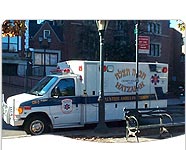 |
 
Child safety: Prevent poisoning
By MayoClinic.com
The average home is full of items that can poison a child. Some of them are self-evident —
roach spray and rat poison. But others are more surprising, such as iron pills, furniture polish,
windshield washer fluid and mouthwash.
You can help prevent childhood poisonings by identifying the poisons in your home and ensuring
that they are stored safely.
Medicines and vitamins
It is possible for a child to die from liver damage after swallowing as few as five adult-strength
vitamin pills with iron. Children can also start vomiting blood or have bloody diarrhea less than an
hour after ingesting even a few iron supplements.
Don't take medicine in front of small children; they often imitate adults. And never refer to
medicine as candy. Adult medications that are especially dangerous for children include:
• Diet pills and other stimulants
• Decongestants
• Antidepressants
• Blood pressure pills
• Iron supplements
Many types of alcohol
When children swallow alcohol, they can potentially have seizures, go into a coma or even die.
And there are many types of alcohol — each used in different household products.
For example, wood alcohol (methanol) is used in antifreeze, windshield washer fluid, shellac,
varnish and paint remover. Other types of alcohol are used in mouthwash, facial cleaners, after-shaves,
cologne and antibacterial hand cleaners.
Household cleaners and fuels
Drain openers, toilet bowl cleaners, rust removers and oven cleaners can cause chemical burns,
which often damage tissue just as much as actual flames do. Dishwasher soap, bleach and ammonia are
all toxic if swallowed. If bleach and ammonia are mixed, they produce a poisonous gas. Ammonia also
comes in the form of smelling salts capsules, which could be mistaken for candy.
Furniture polish is part of a broad category (hydrocarbons) that includes gasoline, kerosene,
lamp oil, motor oil, lighter fluid and paint thinners. Hydrocarbons are among the leading causes of
poisoning death in children.
Pesticides
While most child poisonings involve eating or drinking toxic substances, poisons also can enter
the body through the skin or eyes, or by being inhaled.
For example, many of the chemicals used to kill bugs and other pests can be absorbed through the
skin, or the fumes can be inhaled. Some of these chemicals affect the nervous system and can make it
difficult to breathe.
Carbon monoxide
Carbon monoxide (CO) is a deadly gas produced when fuel is burned. Common sources of CO include
cars, lawn mowers, furnaces, fireplaces and grills.
Most fuel-powered items are designed to reduce the risk of CO poisoning, but they can malfunction
or be used improperly. For example, people often commit suicide by running their cars inside closed
garages allowing deadly levels of CO to be inhaled.
Breathing CO prevents the red blood cells from carrying oxygen. Because children are smaller,
lesser amounts of the gas can harm them. In addition to smoke detectors, every home also should have
a carbon monoxide detector.
Poisonous plants
The fruits, seeds or roots of many common plants are poisonous, including:
• Azalea
• Daffodil
• Elephant's ear
• Foxglove
• Holly
• Iris
• Lily of the valley
• May apple
• Mistletoe
• Morning glory
• Peace lily
Eating any part of a wild mushroom can be very dangerous. Immediately call 1-800-222-1222 and you
will be automatically routed to your local poison control center. If you have pieces of the actual
mushroom that was eaten, save it in a brown paper bag. Many poisonous mushrooms look very much like
edible ones. The visible differences are apparent only to experts.
Safe storage
Store all poisonous household substances out of sight and out of reach. Locked cabinets are best.
Make sure your prescription medications come with child-resistant caps. Close containers right after
you use them.
Keep dangerous substances in the containers they came in. This keeps the safety information on the
label right with the pertinent product. Do not store these products in cups, jars, soft-drink bottles
or milk jugs. Children may think they are OK to eat or drink.
Poisoning clues
If you see a bottle of pills or some other dangerous product standing open or partially spilled,
your child may have gotten into it and become poisoned. Unusual symptoms that may accompany poisoning
include:
• Sleepiness even though it's not nap time
• Inability to follow you with his or her eyes
• Burns or stains around the mouth
• Strange-smelling breath
What to do when you suspect poisoning
If your child is unconscious, having convulsions or having difficulty breathing, call 911 immediately
or take him or her to the closest hospital emergency room.
If your child is conscious, call 1-800-222-1222 and you will be automatically routed to your local poison
control center. Have the following information ready:
• Your child's age and weight
• Descriptions of contents and other facts printed on product containers or medicine bottles
• Time that the poisoning may have occurred
• Your telephone number
Do not induce vomiting
In the past, the American Academy of Pediatrics (AAP) advised parents to keep ipecac syrup, which causes
vomiting, on hand for use if a doctor or poison control center recommended it.
The AAP changed its policy after concluding that ipecac does a poor job of removing poison from the body.
Induced vomiting is also unpleasant, and it may make things worse. If you have ipecac in your home, dispose
of it safely.
Prevent accidental poisoning
More than half of all poison exposures occur in children under the age of 6. Help keep your children safe
by storing dangerous substances properly and teaching your children about the dangers of poisons.
(c) 2005 Mayo Foundation for Medical Education and Research. All rights reserved.
Back to Safety Tips Index
|









